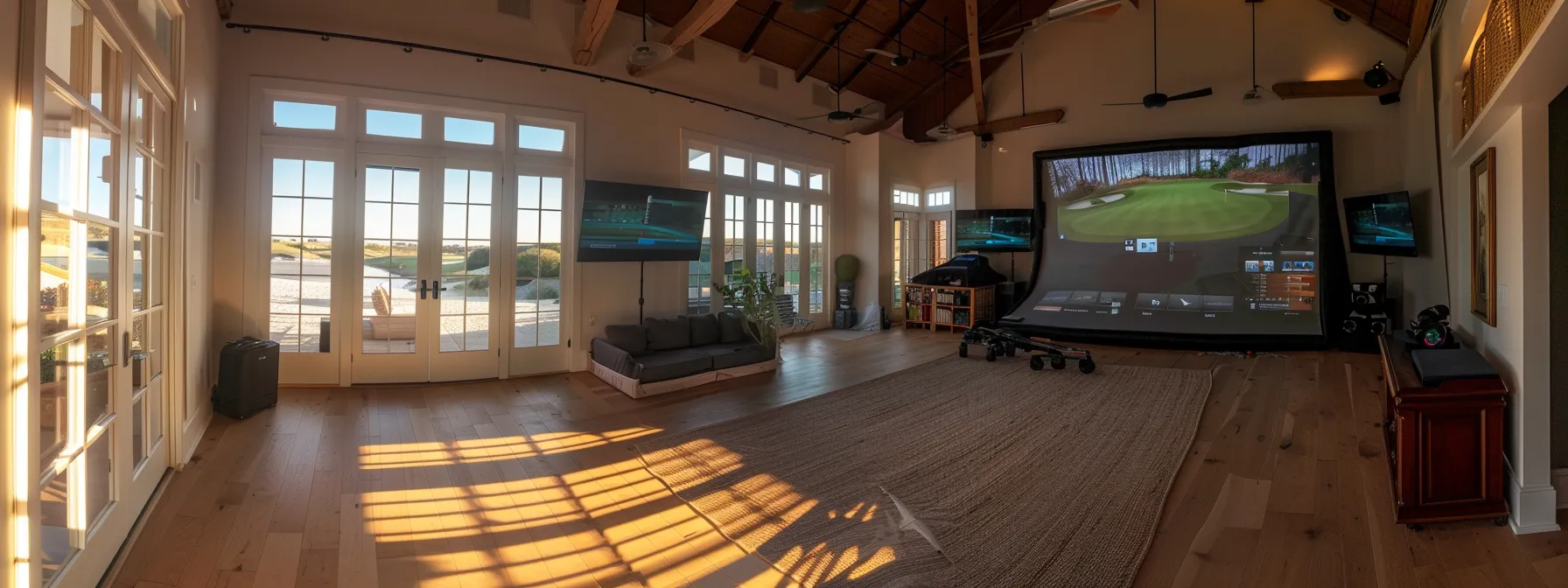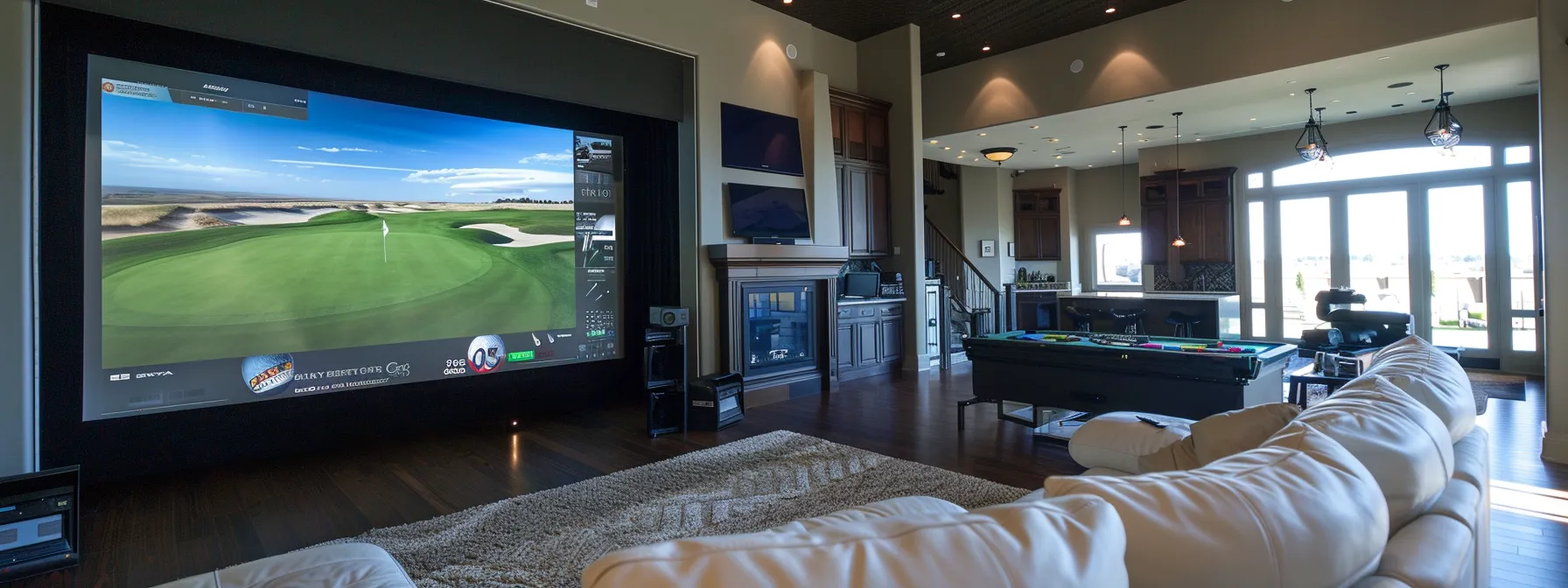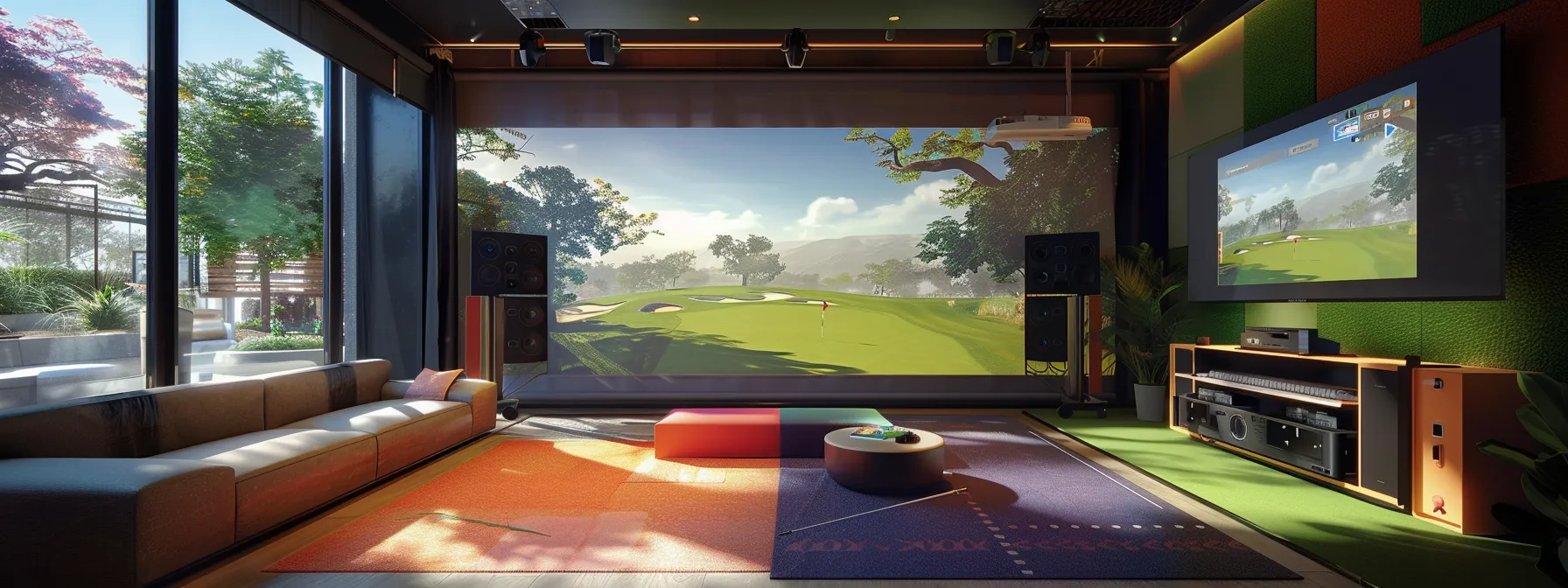Disclaimer: We sometimes use affiliate links in our content. For more information, visit our Disclaimer Page.
Are you struggling to find the right home golf simulator for your space? With various options available, it’s essential to assess your specific needs, budget, and the features that will work best for you. This guide will cover how to evaluate your space, determine your essential requirements, and explore top simulators that incorporate key statistics, motion tracking, touchscreen features, trajectory analysis, and angle of attack metrics. By the end, you’ll have a clear path to selecting a simulator that enhances your at-home golfing experience, solving the dilemma of making the right choice.
Assessing Your Space for a Home Golf Simulator

To effectively choose the perfect home golf simulator, you need to assess several key factors. Start by measuring the dimensions of your room and considering ceiling height requirements, as these will affect the simulation experience. Evaluate lighting conditions for optimal graphics and identify any potential obstructions that could interfere with play. Lastly, decide between a permanent or portable setup based on your available space and preference for convenience.
Measuring the Dimensions of Your Room
Begin by measuring the length, width, and height of your room to make sure it can accommodate a home golf simulator. A standard driving range setup typically requires a minimum space of 10 feet in width and 12 feet in length, along with enough ceiling height to allow for a full swing without interference. If you’re using advanced simulation software, you also want to ensure that there is ample room behind the tee for your stance and swing, which may add to your dimensional needs.
Next, take into consideration the placement of equipment such as a projector, which enhances your simulation experience by projecting visuals on a screen or wall. Make sure there is sufficient distance from where you plan to hit to the projection area for optimal clarity. By thoughtfully measuring your space, you can eliminate potential issues that could affect both your gameplay and the overall enjoyment of your home golf simulator.
Considering Ceiling Height Requirements
When setting up your indoor golf simulator, considering the ceiling height is crucial for an enjoyable experience. A minimum height of 9 to 10 feet is generally recommended to allow for a full swing without any restrictions. If your setup includes equipment like infrared sensors or a rangefinder, having enough vertical space ensures these devices function properly and accurately measure your shots.
Moreover, the right ceiling height can significantly enhance your entertainment experience. Low ceilings can lead to frustration if your swing is interrupted, so be sure to think about how much room you need not only for your own height but also for the trajectory of the ball. As you assess your space for a home golf simulator, a well-measured ceiling height contributes to a more realistic and enjoyable simulation, allowing you to reach your golfing goals effectively.
Evaluating Lighting Conditions
Evaluating lighting conditions is essential when selecting a home golf simulator to ensure an optimal experience. A well-lit room can enhance the performance of your commercial golf simulators, including popular options like the Foresight Sports simulator. If your space lacks natural light, consider installing LED lights that can brighten the area and reduce glare, allowing your golf equipment to function correctly. This setup helps you see the graphics clearly, which is crucial when analyzing your swing and ball trajectory.
Moreover, poor lighting can interfere with various gear, such as laser sensors that track your shots’ accuracy. For example, make sure there is sufficient ambient light without direct sunlight hitting your hitting area. To maintain your focus on the game, test different lighting configurations before making a final decision. By prioritizing appropriate lighting, you can create a comfortable environment that significantly enhances your simulation experience and overall enjoyment of the game.
Identifying Potential Obstructions
Identifying potential obstructions in your space is crucial for maximizing the functionality of a home golf simulator. Look for any furniture, fixtures, or decorations that may hinder your swing or the path of the golf ball. Ensure there’s ample clearance, especially if you plan to use a full swing with your golf club. For instance, the Foresight Sports simulator requires clear sight lines and space to operate optimally, so consider these factors when arranging your room.
Additionally, be aware of the ceiling height and any overhead elements that could pose a risk during your golfing sessions. If your space has low ceilings, you may want to adjust your setup or select a simulator that accommodates your environment. According to Golf Digest, proper clearance not only enhances your gameplay experience but can also impact the longevity of your equipment, so keeping your environment clear of such obstructions is crucial for getting the most value for the price you pay for your simulator.
Choosing Between Permanent and Portable Setups
When deciding between permanent and portable setups for your home golf simulator, consider how often you plan to practice your golf swing and the space you have available. A permanent setup typically offers a more stable environment, allowing for the installation of advanced sensors and doppler radar systems that enhance accuracy and performance. If you frequently work on your putting and other techniques, dedicating space for a permanent simulator might provide the best experience.
On the other hand, if your space is limited or you prefer the flexibility to move your simulator, a portable setup could be the right choice. Portable simulators can be easily assembled and disassembled, allowing you to practice your swing at various angles without permanent fixtures. This option is especially beneficial for those living in smaller homes or apartments, as it offers a great balance of convenience and functionality while still accommodating your golf needs.
You’ve measured your space and found its potential. Now, it’s time to turn to your needs and desires for the perfect golf simulator.
Determining Your Golf Simulator Needs

Start by clarifying your skill level and goals, as this will guide your choice of home golf simulator. Consider whether you want a setup focused on practice or entertainment, along with single or multiplayer options to suit different playing experiences. Understanding the available proprietary software and course offerings can enhance your gameplay, similar to experiences at places like topgolf. Don’t forget to factor in the necessary graphics card and potential integration with training aids to maximize your performance.
Clarifying Your Skill Level and Goals
Understanding your skill level and goals is crucial when selecting a home golf simulator. If you are a beginner, you may want a simulator that focuses on basic swings and offers instructional software to help you improve your game. For more advanced players, a simulator with sophisticated features like shot analysis and access to real golf courses could be more beneficial, enhancing your practice sessions and keeping your game sharp.
Moreover, deciding whether you prefer individual practice or multiplayer experiences can guide your choice. If practicing alone is your focus, look for simulators that provide comprehensive training programs and detailed feedback. Conversely, if you enjoy playing with friends or family, select options that cater to social interaction and competitive play. By clarifying your skill level and goals, you can choose a simulator that truly meets your needs and enhances your overall golfing experience.
Selecting Between Practice and Entertainment Focus
When selecting a home golf simulator, you should first consider whether your primary focus is on practice or entertainment. If you aim to improve your skills, look for simulators that offer in-depth analysis, swing feedback, and various training modes. This type of setup will help you track your progress and adjust your technique effectively, making each practice session productive.
On the other hand, if your goal is to have fun and socialize, prioritize features that allow for multiplayer experiences and interactive games. Many simulators include a variety of courses and challenges, mimicking the excitement of a real golf outing. By understanding whether you lean towards practice or entertainment, you can choose a simulator that truly enriches your home golfing experience.
Deciding on Single or Multiplayer Options
When deciding whether to choose a single or multiplayer golf simulator, think about how you plan to use the system. If you prefer practicing alone, focus on simulators that offer detailed performance analysis and feedback tailored to individual players. These options allow you to work specifically on your swing mechanics and track your progress over time, making it easier for you to improve your game.
If you envision enjoying golf with family or friends, look for a simulator that supports multiplayer experiences. Many modern systems come with features for head-to-head competitions, interactive games, and the ability to play on various courses. This setup not only makes your practice sessions more engaging but also transforms your space into a social hub for golf enthusiasts, enhancing your overall enjoyment of the sport.
Understanding Software and Course Availability
Understanding the available software and course options is essential when choosing a home golf simulator. Many modern simulators offer proprietary software that includes various golfing scenarios and analyses feedback from your swings. Look for systems that provide access to real-world golf courses and training programs tailored to your skill level, as these features can greatly enhance your practice sessions and overall enjoyment.
Additionally, consider whether the software supports updates and new courses, as this can keep your experience fresh and engaging. A simulator that includes interactive gameplay and multiplayer options can make your practice sessions more enjoyable, encouraging you to spend more time improving your skills. By selecting a simulator with robust software and diverse course availability, you ensure that your home setup remains stimulating and effective over time.
Considering Integration With Training Aids
Considering the integration of training aids with your home golf simulator can greatly enhance your practice sessions. Many simulators offer compatibility with devices like swing analyzers or putting mats that provide instant feedback on your performance. For instance, using a launch monitor can help you understand your shot mechanics, allowing you to make informed adjustments to your technique.
Furthermore, incorporating training aids creates a more comprehensive learning environment, catering to both beginners and advanced players. Your choice of simulator should support these tools, enabling you to track progress over time and refine specific skills. By ensuring your setup accommodates training aids, you will maximize your investment and transform your practice routine into an effective learning experience.
Now that you’ve assessed what you need for your golf simulator, it’s time to think about the cost. Setting a budget will guide your choices and help you make the right decisions for your setup.
Setting a Budget for Your Home Golf Simulator

When setting a budget for your home golf simulator, it’s important to compare the costs of entry-level and premium systems. Identify any hidden expenses, such as installation and accessories, to plan effectively. Explore financing options to make your purchase more manageable, and balance cost with the features you desire. Prioritize essential components to ensure you get the best value for your investment in a home golf simulator.
Comparing Costs of Entry-Level and Premium Systems
When comparing costs of entry-level and premium home golf simulators, you should first consider your budget and intended usage. Entry-level systems usually range from $1,500 to $3,000 and offer basic functionalities, making them suitable for beginners or casual golfers. If you are new to the sport and want to enhance your skills without a significant investment, these options can effectively meet your needs.
On the other hand, premium systems can range from $5,000 to over $20,000 and deliver advanced features such as realistic graphics, high-speed cameras, and detailed analytics. For serious golfers who want a lifelike experience and comprehensive training tools, investing in a premium simulator may be worthwhile. By understanding the difference in costs and features, you can better align your budget with the right system that caters to your golfing aspirations.
Identifying Hidden Expenses
When planning your budget for a home golf simulator, it’s crucial to identify hidden expenses that can add up quickly. Beyond the initial purchase price of the simulator, consider costs for installation, additional equipment like screens or projectors, and ongoing maintenance. For instance, some simulators may require specific flooring or protective mats to ensure proper functionality, which can lead to additional costs that you might not have initially anticipated.
Additionally, you should factor in expenses for updates or subscriptions to software that provide access to new golf courses or enhanced features. Some systems might offer enticing promotional prices, but remember, the full cost could include necessary accessories like launch monitors or swing analysis tools. By thoroughly evaluating these hidden expenses, you can set a more accurate budget and avoid unexpected financial strain while selecting the ideal home golf simulator for your space.
Exploring Financing Options
When considering financing options for your home golf simulator, explore various payment plans that can ease the financial burden. Many retailers and manufacturers offer financing through monthly payment plans, which can help you spread the cost over time. This allows you to invest in a quality simulator without compromising your budget, making it easier to achieve your golfing goals.
Additionally, you may find that some credit companies provide promotional interest rates for specific purchases, which can be particularly beneficial for high-ticket items like golf simulators. By taking advantage of these financing options, you can prioritize purchasing a simulator that meets your needs while managing cash flow and ensuring you can enjoy your home golfing experience without undue financial strain.
Balancing Cost With Desired Features
When you’re choosing a home golf simulator, finding the right balance between cost and desired features is key to making a wise investment. Understand that while the allure of high-end models with advanced capabilities can be tempting, it’s crucial to evaluate which features truly enhance your experience. For example, if you mainly focus on improving your swing mechanics, a mid-range simulator may offer sufficient features without exceeding your budget.
Additionally, think about what specific features will benefit your practice the most. If multiplayer capabilities or realistic graphics are essential to you, prioritize those aspects when assessing your options. Rather than settling for just the lowest price, consider how each feature aligns with your golfing goals. By striking the right balance between cost and features, you can create a satisfying home golfing environment tailored to your needs.
Prioritizing Essential Components
When setting your budget for a home golf simulator, it’s important to prioritize essential components that directly impact your overall experience. Focus on key elements such as the simulator software, launch monitors, and impact screens, as these play a critical role in delivering accurate feedback and realistic gameplay. Investing in quality software that is compatible with a variety of golf courses can enhance your practice sessions, making it essential to weigh these factors against your budget constraints.
Additionally, consider the additional accessories that can enhance your golfing experience, like projectors and protective flooring. These items, while potentially adding to your expenses, can significantly improve functionality and safety during use. By identifying which components are necessary for your specific goals, you can allocate your budget effectively and ensure that your home simulator setup meets your needs without overspending.
With your budget set, it’s time to explore options that fit your plan. The right golf simulator awaits, ready to bring the course to your home.
Exploring the Best Golf Simulators for Home Use

Exploring the Best Golf Simulators for Home Use
In this section, you’ll review top-rated golf simulators to find the one that suits your needs. You will compare launch monitor technologies to understand how they impact performance. Analyzing data accuracy and feedback will help you make informed decisions, while assessing graphics and immersion level enhances your experience. Finally, reading user experiences and testimonials provides valuable insights into real-world usage.
Reviewing Top-Rated Models
When exploring the best golf simulators for home use, consider models like the SkyTrak and TrackMan. These simulators are highly regarded for their accuracy and realistic gameplay, offering a range of features that cater to different skill levels. The SkyTrak, in particular, provides instant feedback on your swing and ball flight, making it an excellent choice for those looking to improve their game without breaking the bank.
Another top-rated option is the Foresight Sports GCQuad, known for its advanced launch monitor technology and detailed performance metrics. This model delivers incredibly precise data, which helps you analyze your shots effectively and make informed adjustments. By reviewing these top-rated models, you can find a simulator that fits your specific needs and enhances your home golfing experience.
Comparing Launch Monitor Technologies
When comparing launch monitor technologies, consider how they affect your overall experience with a home golf simulator. Devices like radar-based launch monitors, such as TrackMan, offer high accuracy by using Doppler radar to track the ball’s flight path. This technology allows for detailed feedback on ball speed, angle, and distance, giving you insights that can enhance your practice sessions.
Alternatively, camera-based launch monitors, like SkyTrak, utilize high-speed cameras to capture swing data, which can be a great choice for those looking to analyze their technique closely. These systems can provide instant feedback on swing metrics, helping you make essential adjustments. By understanding the differences in launch monitor technologies, you can select a simulator that meets your specific training needs and contributes to your golfing success.
Analyzing Data Accuracy and Feedback
When selecting a home golf simulator, analyzing data accuracy and feedback is essential for improving your game. You want a simulator that delivers precise metrics on aspects like swing speed, ball path, and impact angle. For example, systems utilizing Doppler radar, such as TrackMan, provide superior accuracy by tracking the ball’s flight, giving you valuable insights for adjustment.
Additionally, immediate feedback is crucial for effective practice. Look for simulators that offer detailed swing analysis, allowing you to see the areas that need improvement. For instance, units like SkyTrak provide data in real-time, helping you to make quick adjustments during your practice sessions. By focusing on simulators with strong data accuracy and immediate feedback, you can enhance your overall golfing experience and reach your goals more effectively.
Assessing Graphics and Immersion Level
When assessing graphics and immersion level for home golf simulators, consider how these features enhance your overall experience. High-quality graphics can make virtual courses feel more realistic, allowing you to immerse yourself in the gameplay. For example, simulators with 3D graphics provide lifelike environments that mimic actual golf courses, making practice sessions enjoyable and engaging.
In addition to visuals, the immersion level also relies on sound and interactivity. Some simulators come with realistic sound effects that replicate the ambiance of a golf course, enriching your experience. By choosing a simulator with strong graphics and immersive features, you create a more compelling practice environment that keeps you motivated and focused on improving your golf skills.
Reading User Experiences and Testimonials
Reading user experiences and testimonials is an effective way to gain insight into the performance of different home golf simulators. Real users often share their satisfaction levels, the accuracy of the feedback provided, and how the setup integrates into their space. For instance, someone might highlight how the SkyTrak simulator not only improved their swing mechanics but also fit seamlessly in their smaller living room, making it an ideal choice for limited spaces.
Furthermore, testimonials can help you identify any potential drawbacks before making a purchase. Users may discuss issues such as installation challenges or specific requirements like optimal lighting conditions for certain models. By considering these firsthand experiences, you can make a more informed decision that aligns with your needs and preferences, ensuring that your selected home golf simulator offers both value and functionality.
Choosing the right golf simulator is only the beginning. Next, you’ll want to ensure it’s set up correctly for the best experience in your home.
Installation and Setup of Your Golf Simulator

Preparing your space for installation is the first step in setting up your home golf simulator effectively. This involves assembling the necessary hardware components, establishing software and connectivity, and calibrating the system for optimal performance. Additionally, you’ll learn tips for ongoing maintenance to ensure your simulator remains in top shape. Each step is essential for maximizing your golfing experience at home.
Preparing Your Space for Installation
Preparing your space for the installation of a home golf simulator starts with evaluating your room dimensions and layout. Measure the length, width, and ceiling height to ensure you have enough space for a full swing and any necessary equipment, like projectors or screens. Create a clear area, free from obstacles, to allow for smooth gameplay and facilitate easy access to all components of your simulator setup.
Next, focus on setting up electrical outlets and ensuring stable internet connectivity. A reliable power source is essential for your simulator and additional devices, while a strong internet connection aids in software updates and online play. By taking these steps to prepare your space, you position yourself for a seamless installation process, enhancing your overall experience with the simulator and ensuring every practice session is productive.
Assembling Hardware Components
Assembling hardware components for your home golf simulator is a straightforward process that requires careful attention to detail. Start by organizing all the components in your workspace, ensuring you have everything from the simulator unit to the necessary cables and mounts. Taking your time during assembly can prevent future issues, allowing you to create a smooth gameplay experience right from the start.
When setting up items like projection screens and sensors, be sure to follow the manufacturer’s instructions for precise installation. Proper placement of these components is crucial for accuracy and performance; for example, positioning the projector at the correct distance ensures that the visuals are clear and engaging. As you complete the assembly, verify that all connections are secure, which will help you avoid interruptions during your practice sessions and maximize your enjoyment of the home simulator.
Setting Up Software and Connectivity
Setting up the software for your home golf simulator is key to a seamless golfing experience. Start by following the installation instructions provided with your simulator. Ensuring you have the latest version of the software will improve compatibility and performance. This is especially important if you plan to connect to online features or downloadable courses, as updates often include enhancements that can significantly affect your gameplay.
Moreover, reliable internet connectivity is essential for smooth operation and access to online features. Make sure your setup is close to a Wi-Fi router or consider using a wired connection for more stability. A strong connection not only supports live updates but also enhances features like multiplayer gaming. With these steps, you can create a well-functioning home golf simulator setup that meets your needs and elevates your practice sessions.
Calibrating for Optimal Performance
Calibrating your home golf simulator is essential for ensuring accurate performance and an enjoyable gameplay experience. Start by following the manufacturer’s calibration instructions, which usually involve adjusting the sensors or launch monitors based on your specific setup. This fine-tuning allows your simulator to accurately track your shots, providing valuable data such as swing speed, ball speed, and launch angle, which can significantly enhance your practice sessions.
Additionally, regular calibration checks are important as your setup can shift over time. If you notice discrepancies in shot data or performance feedback, it may indicate that recalibration is needed. Make it a habit to test the system after any significant changes in your environment, such as moving furniture or adjusting lighting conditions. By prioritizing calibration, you can optimize your home golf simulator’s accuracy, helping you reach your golfing goals effectively.
Tips for Ongoing Maintenance
To maintain your home golf simulator effectively, it’s essential to regularly check all components for any signs of wear or damage. Inspect cables and connectors for fraying, and ensure that sensors are clean and properly aligned. Taking the time to clean your equipment, including the hitting area, will help preserve its functionality and prolong its lifespan, allowing you to enjoy uninterrupted practice sessions.
Additionally, consider performing software updates periodically to access new features and enhancements that can improve your golfing experience. Keeping your software current not only optimizes performance but can also fix bugs or compatibility issues that arise over time. By committing to these maintenance practices, you create a reliable setup that accurately tracks your game and supports your golfing goals.
Your golf simulator is ready, and the excitement builds. Now, let’s turn that setup into an unforgettable at-home experience.
Maximizing Your at-Home Golf Experience

To maximize your at-home golf experience, consider enhancing realism with accessories that improve gameplay. Utilize data from your simulator to track performance and identify areas for improvement. Engaging with online golf communities can provide tips and support, while scheduling regular practice sessions keeps your skills sharp. Lastly, staying updated with software upgrades ensures you benefit from the latest features and enhancements.
Enhancing Realism With Accessories
To enhance realism in your home golf simulator, consider adding realistic accessories such as high-quality impact screens and adjustable golf nets. These accessories not only protect your walls but also create a more immersive environment, allowing you to focus on perfecting your swing. Upgrading your setup with accessories like a premium launch monitor can also provide precise feedback on your performance, helping you make informed adjustments.
Additionally, incorporating items like golf mats and putting greens can significantly improve your practice sessions. A good golf mat simulates real turf, providing accurate feedback on ball interaction. You might also find that including putting surfaces helps you refine your short game skills, making your overall experience more engaging and enjoyable. By selecting the right accessories, you create a dynamic setup that meets your golfing needs and enhances your at-home experience.
Utilizing Data to Improve Your Game
Utilizing data from your home golf simulator is key to effectively improving your game. By analyzing metrics such as swing speed, ball speed, and launch angle, you can gain valuable insights into your performance. For example, if your simulator indicates that your ball speed is consistently lower than desired, you may need to adjust your stance or swing technique to achieve better results.
Incorporating this data into your practice routine allows you to set specific improvement goals that align with your golfing objectives. You can track your progress over time, helping you identify patterns and areas that require further focus. Engaging with this data not only streamlines your practice sessions but also enhances your overall enjoyment of the game, turning every swing into an opportunity for growth and better performance.
Connecting With Online Golf Communities
Connecting with online golf communities can significantly enhance your at-home golfing experience. You can join forums and social media groups where enthusiasts share tips, experiences, and advice on using home golf simulators. Engaging with these communities allows you to learn from others and discover ways to maximize your simulator’s features, making your practice sessions more effective and enjoyable.
Involvement in these online communities can also help you stay motivated. By sharing your progress and challenges with fellow golf enthusiasts, you create a support network that encourages regular practice and skill development. This interaction not only fosters accountability but also opens up opportunities for friendly competitions or collaborative learning, further enriching your home golf simulator experience.
Scheduling Regular Practice Sessions
Regular practice sessions are vital to improving your skills and getting the most out of your home golf simulator. Setting aside specific times each week allows you to create a structured routine that fosters consistency. By scheduling these sessions, you not only develop muscle memory but also enhance your overall performance, making each practice session more productive and focused.
To effectively integrate regular practice into your routine, consider using your simulator’s data to track progress over time. For instance, after each session, review metrics like swing speed and ball accuracy to identify areas that need improvement. This approach not only keeps you motivated but also aids in setting achievable goals, ensuring you derive maximum benefit from your home golf simulator and continually advance your golfing abilities.
Staying Updated With Software Upgrades
Staying updated with software upgrades is essential for optimizing your home golf simulator’s performance. Regular updates often include new features, improved graphics, and enhanced gameplay options that can significantly elevate your golfing experience. For instance, accessing the latest course updates or gameplay enhancements keeps your practice sessions engaging and ensures you are benefiting from technological advancements that improve accuracy and realism.
Moreover, checking for software updates can help you identify any issues or bugs that may arise, allowing you to enjoy a smoother operation. By regularly updating your simulator, you also maintain compatibility with new devices or accessories that you might want to incorporate later on. This proactive approach not only maximizes the functionality of your home golf simulator but also helps you stay aligned with evolving trends in golf technology, enhancing your overall at-home experience.
Conclusion
Selecting the ideal home golf simulator is crucial for maximizing your golfing experience and achieving your practice goals. By carefully assessing your space, including dimensions, ceiling height, and lighting conditions, you can create an optimal environment for gameplay. Understanding your specific needs—whether for skill development or entertainment—helps you choose a simulator that perfectly fits your lifestyle. Ultimately, the right setup not only enhances your enjoyment of the game but also contributes to your improvement as a golfer.





